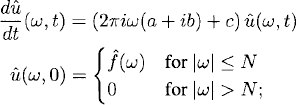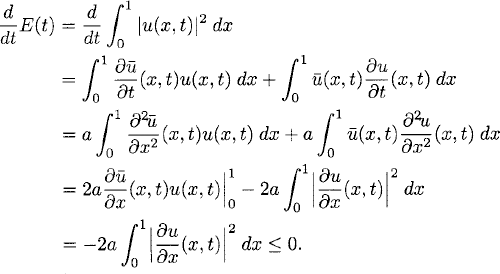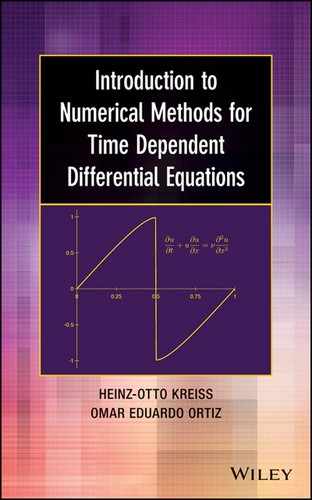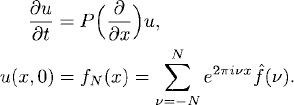CHAPTER 8
1-PERIODIC SOLUTIONS OF TIME DEPENDENT PARTIAL DIFFERENTIAL EQUATIONS WITH CONSTANT COEFFICIENTS
We start this chapter by studying three simple examples of partial differential equations and their initial value problems in the 1-periodic case. These examples are fundamental as model equations and to introduce the concepts of well posedness and stability under lower-order perturbations. At the end we generalize these concepts to more general equations and systems of equations.
8.1 Examples of equations with simple wave solutions
8.1.1 One-way wave equation
Perhaps the simplest example is the one-way wave equation
with initial data:
We solve the problem by separation of variables; that is, we assume that
By (8.2),
![]()
Introducing (8.3) into (8.1) gives us
(8.4) ![]()
Therefore,
![]()
and by (8.3),
We can now use the results of Section 7.2 and the principle of superposition to solve (8.1) for general initial data

and obtain
By Parseval’s relation we obtain the energy estimate1
8.1.2 Heat equation
Consider now the heat equation
with initial data (8.2). Again we solve the problem by the separation of variables (8.3) and now obtain
(8.9) ![]()
Instead of (8.5), we now obtain
There is a fundamental difference between the behavior of (8.5) and (8.10). For the one-way wave equation, the amplitude of the solution does not change with time. For the heat equation, the amplitude decays rapidly with time if ω is large.
Again, by Section 7.2 and the principle of superposition, we can solve (8.1) for general initial data

and obtain
(8.11) 
For general initial data, the solution (8.6) has, for t > 0, the same smoothness properties as those of the initial data. For the heat equation, it is C∞-smooth for t > 0. Therefore, it is much easier to solve (8.8) than (8.1) numerically.
Finally, corresponding to (8.7), we obtain for the heat equation an energy estimate
(8.12) 
8.1.3 Wave equation
Consider finally the wave equation,
For constant initial data the solution is simply u(x, t) = σ1 + σ2t. For nonconstant initial data we start by studying simple wave solutions. We again make the ansatz (8.3)
![]()
and obtain a second-order ordinary differential equation
(8.14) ![]()
Its general solution is of the form
(8.15) ![]()
We need two initial conditions,
(8.16) ![]()
Thus,

and

Thus,
Equation (8.17) consists of two solutions of type (8.6). We can again use the results of Section 7.2 and the principle of superposition to solve (8.13) for the general data
(8.18) 
Then the general solution is
(8.19) 
Again we obtain an energy estimate that, for vanishing ![]() 1 (0) and
1 (0) and ![]() 2(0), is
2(0), is
Exercise 8.1 Derive estimate (8.20).
8.2 Discussion of well posed problems for time dependent partial differential equations with constant coefficients and with 1-periodic boundary conditions
8.2.1 First-order equations
We start with
Because (8.21) is of the same type as the first example of Section 8.1, we could proceed as before, using the ansatz (8.3). However, we shall Fourier transform the problem directly. Since the Fourier transform of fN(x) consists of a finite number of frequencies, we know that the solution of (8.21) exists and is C∞-smooth. We obtain

Integration by parts with respect to x, and taking the time derivative outside the integral, gives us
(8.22) 
that is, for |ω| ≤ N,
(8.23) ![]()
The corresponding simple wave solution is given by
(8.24) ![]()
that is,
(8.25) ![]()
Inverting the Fourier series, we obtain
and by Parseval’s relation we obtain the energy estimate
(8.27) 
Using the ansatz (8.3), we would have obtained the same result.
For every fixed N there is a bounded solution. However, even if ω is of moderate size, the corresponding simple wave solution can grow rapidly with time. For example, if ωb = −10, t = 10, c = 0, then
![]()
In numerical calculations, due to truncation errors, all frequencies are activated, that is |ω| → ∞. Therefore, we cannot calculate the solutions if ωb < 0, and we call the problem illposed.
On the other hand, if b = 0, then
![]()
If c > 0, there is exponential growth but it does not depend on ω. This is quite common in applications and we have to live with it. In this case we call the problem well posed. The most benign situation occurs when c ≤ 0 because there is no growth at all (see the first example in Section 8.1); we call the problem strongly well posed.
8.2.2 Second-order (in space) equations
Now we add a second-order term to (8.21) and consider
As before, we Fourier transform (8.28) and obtain
(8.29) 
Therefore, for |ω| ≤ N,
![]()
that is,
The behavior of the simple wave solution is determined by d.
![]()
![]()
![]()
8.2.3 General equation
We summarize our results. Consider
Here

We solve the problem by Fourier transform. Since
![]()
we obtain

Here ![]() is called the symbol of the differential operator P(∂/∂x). The corresponding simple wave solution is given by
is called the symbol of the differential operator P(∂/∂x). The corresponding simple wave solution is given by
![]()
Therefore,
![]()
By the superposition principle, the general solution of problem (8.31) is given by (8.26). The well posedness of the problem is characterized in terms of the symbol in the following theorem.
Theorem 8.1 Problem (8.21) is ill posed if there is a sequence ωj such that
![]()
It is well posed if there is a constant K such that for all ω,
![]()
It is strongly well posed if K ≤ 0.
8.2.4 Stability against lower-order terms and systems of equations
We consider problem (8.31) and assume that an ≠ 0. Then we call an∂n/∂xn the principal part of the differential operator P(∂/∂x), and the other terms, lower-order terms. By Theorem 8.1 it is clear that for our model problems (8.21) and (8.28), the lower-order terms have no influence as to whether the problems are well posed.
To generalize this result to hyperbolic and parabolic systems of equations we will use energy estimates. Before considering systems we want to show how to get energy estimates for the one-way wave and the heat equations without using the Fourier representation. We construct energy estimates in the physical space by applying integration by parts, a powerful technique that can also be applied to nonperiodic problems.
One-way wave equation. We again consider equation (8.1) with initial data u(x, 0) = f(x), with f a smooth 1-periodic function. The energy is defined as
The energy is conserved in this problem. Integration by parts gives us

where the first term vanished because of the periodicity. Therefore, by integrating in time we get
(8.33) ![]()
which is equivalent to (8.7).
Heat equation. Now consider equation (8.8) with initial data u(x, 0) = f(x), smooth, and 1-periodic. The energy is again defined by (8.32) and decays for this problem.

The energy strictly decays until the solution becomes constant. In general,
(8.34) ![]()
Systems of equations. We now generalize the result of the preceding section to 1-periodic hyperbolic and parabolic systems in one space dimension. We consider the hyperbolic system
Here u = (u1, u2, …, un)T is a vector-valued function with complex components and A, B are constant n x n matrices with A real, nonsingular, and symmetric.
We also consider a parabolic system of the form
where D is symmetric and positive definite. To begin with, we neglect lower-order terms and consider
(8.37) ![]()
Since A, D are symmetric, there are unitary matrices U1 and U2 which transform, respectively, A and D to diagonal form. Therefore, we make the change of variables u = U1![]() , u = U2
, u = U2![]() , respectively, and obtain
, respectively, and obtain
(8.38) ![]()
Here λj, j = 1,2, are real diagonal matrices and λ2 is positive definite. Thus, we have reduced our problems to scalar equations, and the initial value problems are well posed.
Systems (8.35) and (8.36) can, in general, not be reduced to diagonal form. Therefore, we use integration by parts.
The L2-norm for a vector-valued function u is
![]()
Here | | is the Euclidean norm introduced in Chapter 6.
For (8.35),

Since

where we use the induced matrix norm (see Definition 6.1), we obtain
![]()
and, integrating, the energy estimate follows for system (8.35).
For (8.36),
Observing that D is positive definite, integration by parts gives us
Here δ is the smallest eigenvalue of D. Also,
Using (8.40) and (8.41) in (8.39), we obtain
Integrating, we get the energy estimate for (8.36).
Exercise 8.2 Show (8.42).
As with scalar equations, the lower-order terms have no influence on whether the problem is well. However, they have do have an influence on whether the problem is strongly well posed.
A very general theory for systems of differential equations in any number of space dimensions has been developed in [[7], Chapter 2]. From the point of view of well posedness, for parabolic systems, symmetric hyperbolic systems, and mixed hyperbolic-parabolic systems, the lower-order terms can be neglected.
1 It is usual, in the context of PDE theory, to call energy the L2-norm (or some other Sobolev norm) of the solution. This energy is not necessarily related to physical energy.









